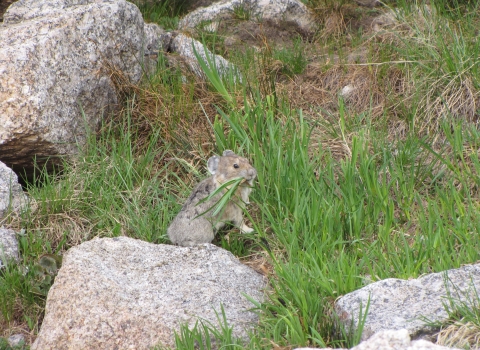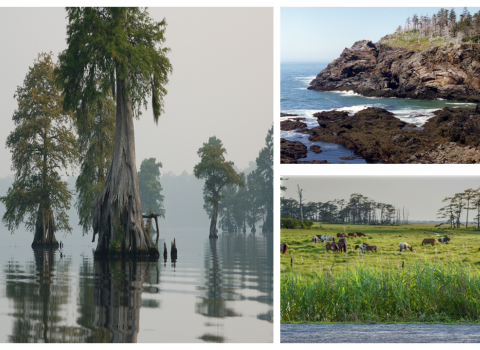The first-ever “Salt Marsh Steward” program at Great Meadows Marsh in Stratford, Connecticut, employed 12 students from nearby high schools during Spring 2022. In a mutually beneficial arrangement, students worked part-time replanting portions of the marsh that had been excavated and graded as part of a $4.6-million restoration project.
Great Meadows Marsh is among Connecticut's most extensive remaining salt marshes, designated a “Globally Important Bird Area” by the National Audubon Society and BirdLife International. More than 15 years in the making, the project is a partnership between the U.S. Fish and Wildlife Service, Audubon Connecticut, the Connecticut Department of Energy and Environmental Protection (CT DEEP), the National Oceanic and Atmospheric Administration (NOAA), and the Town of Stratford.
Plugging away
Although the partner organizations long anticipated the restoration, many community members remained unaware of the ecological benefits and recreational opportunities at Great Meadows Marsh, which serves as the backdrop to their daily lives. Audubon Connecticut staff designed the Salt Marsh Steward program to remedy that, giving local teens the chance to earn money and learn about salt marsh salt marsh
Salt marshes are found in tidal areas near the coast, where freshwater mixes with saltwater.
Learn more about salt marsh ecology, climate change climate change
Climate change includes both global warming driven by human-induced emissions of greenhouse gases and the resulting large-scale shifts in weather patterns. Though there have been previous periods of climatic change, since the mid-20th century humans have had an unprecedented impact on Earth's climate system and caused change on a global scale.
Learn more about climate change , and conservation careers.
With support from Audubon Connecticut staff members Jack Matthias, Corrie Folsom-O'Keefe, and Will Perret, and crew leaders Allison Middlemass, Faith Bouffard, and Mike DiGioia, the students began planting shrubs and grass “plugs” in April 2022. They frequently worked alongside volunteers from local—and not-so-local—organizations, including Avalon Nature Preserve, The Maritime Aquarium at Norwalk, Connecticut’s Beardsley Zoo, Sacred Heart University, and Athletic Brewing Co. This provided an opportunity to meet people from all walks of life, united in their goal to assist with the restoration of their local wildlife refuge. The Salt Marsh Stewards and volunteers helped place more than 155,000 individual plants at Great Meadows Marsh in less than three months.
For many of the Salt Marsh Stewards, the position was their first “real job.” They gained an understanding of work ethic and experienced working outdoors under challenging weather conditions, including high winds, intense sun, and rain. They cultivated critical interpersonal skills, such as working and communicating cooperatively with others and as part of a team outside the school setting. Many of the students didn’t know each other at the start but made lasting friendships over the course of the project.
Broadening horizons
In addition to re-planting the recently excavated marsh, Salt Marsh Stewards participated in team-building and exploratory activities. During bird walks in the marsh, Folsom-O'Keefe instructed the team on clues for bird identification, including appearance, vocalizations, and behaviors. Many stewards were amazed by the number of different bird species that rely on salt marshes, even in more urban areas like Stratford. Especially memorable were the many great egrets and ospreys that call Great Meadows Marsh home.
The stewards gained a unique and intimate understanding of several native salt marsh plants that they planted around the site, including saltmeadow cordgrass (Spartina patens), smooth cordgrass (Spartina alterniflora), spikegrass (aka saltgrass or saltmarsh hay; Distichlis spicata), panic grass (Panicum virgatum) and seaside goldenrod (Solidago sempervirens). The stewards learned about the importance of these native plants to rare species, including the saltmarsh sparrow and diamondback terrapin.
The group also learned about the impacts of sea-level rise on salt marshes and how minute differences in marsh elevation affect marsh formation, plant survival, and the creation of long-term saltmarsh sparrow habitats.
One steward, Amelis Medina, reflected, "This [program] brings you out into nature that many underappreciate and provides you [with] the opportunity to experience real work." She said she is glad to have learned about Phragmites, or common reed, an invasive plant that dominated the landscape at Great Meadows Marsh before the restoration.
The Salt Marsh Stewards met and interacted with several local conservation professionals. Kris Vagos, a biologist at Stewart B. McKinney National Wildlife Refuge, spoke about her varied job history and indirect career path and how she eventually found her calling in conservation with her current role.
The stewards also met Kelly Kerrigan, the environmental conservation superintendent for the Town of Stratford. Kerrigan spoke of her job history, current role, responsibilities, and some of her favorite aspects of the job, including working as a tree warden and with other conservation organizations and businesses.
Folsom-O'Keefe, director of bird conservation for Audubon Connecticut, hopes the program will inspire more youth to pursue careers in conservation. “My dream is to see some of the Salt Marsh Stewards return as crew leaders and ultimately, maybe one day, as Audubon employees or staff at other conservation organizations,” she said.
When asked to reflect on their experiences, Chloe Atkins said she was "glad to be making a positive impact on the environment." Anna Flockhart added that she "enjoyed meeting new people." Amelis was impressed with the hundreds of enthusiastic volunteers willing to take unpaid time to help restore the marsh.
Toward the end of the season, the Salt Marsh Stewards got to show their work to their peers when members of the sophomore class from Stratford and Bunnell high schools were brought to Great Meadows Marsh for a day of learning and exploration.
After their positions ended, three former Salt Marsh Stewards (Amelis, Anna, and Hilary) volunteered to help create marsh pink (Sabatia stellaris) habitat at Great Meadows. Amelis and Chloe spoke to policymakers and project partners during a grand opening event in August, noting that their experience as Salt Marsh Stewards inspired a shift in their career interests. During a tour for event attendees, Noah Moon and Madison Thomas-Ferguson pointed out restoration areas the stewards had worked on and spoke about the turtle habitat improvement at the marsh.
Looking ahead
The work is not done. Parts of the marsh weren’t included in the first round of planting, and some young plants struggled with the late summer heat. Other activities will consist of controlling invasive species invasive species
An invasive species is any plant or animal that has spread or been introduced into a new area where they are, or could, cause harm to the environment, economy, or human, animal, or plant health. Their unwelcome presence can destroy ecosystems and cost millions of dollars.
Learn more about invasive species resprouts for the next few years and adaptive management techniques such as constructing runnels, or small channels, to help drain wet areas.
Audubon plans to offer the Salt Marsh Steward program again next year to continue work on the restoration. Some of this year’s team members are interested in returning as crew leaders. They’ll have the chance to guide their peers in developing skills and knowledge for the future...as individuals, community members, and global citizens.







